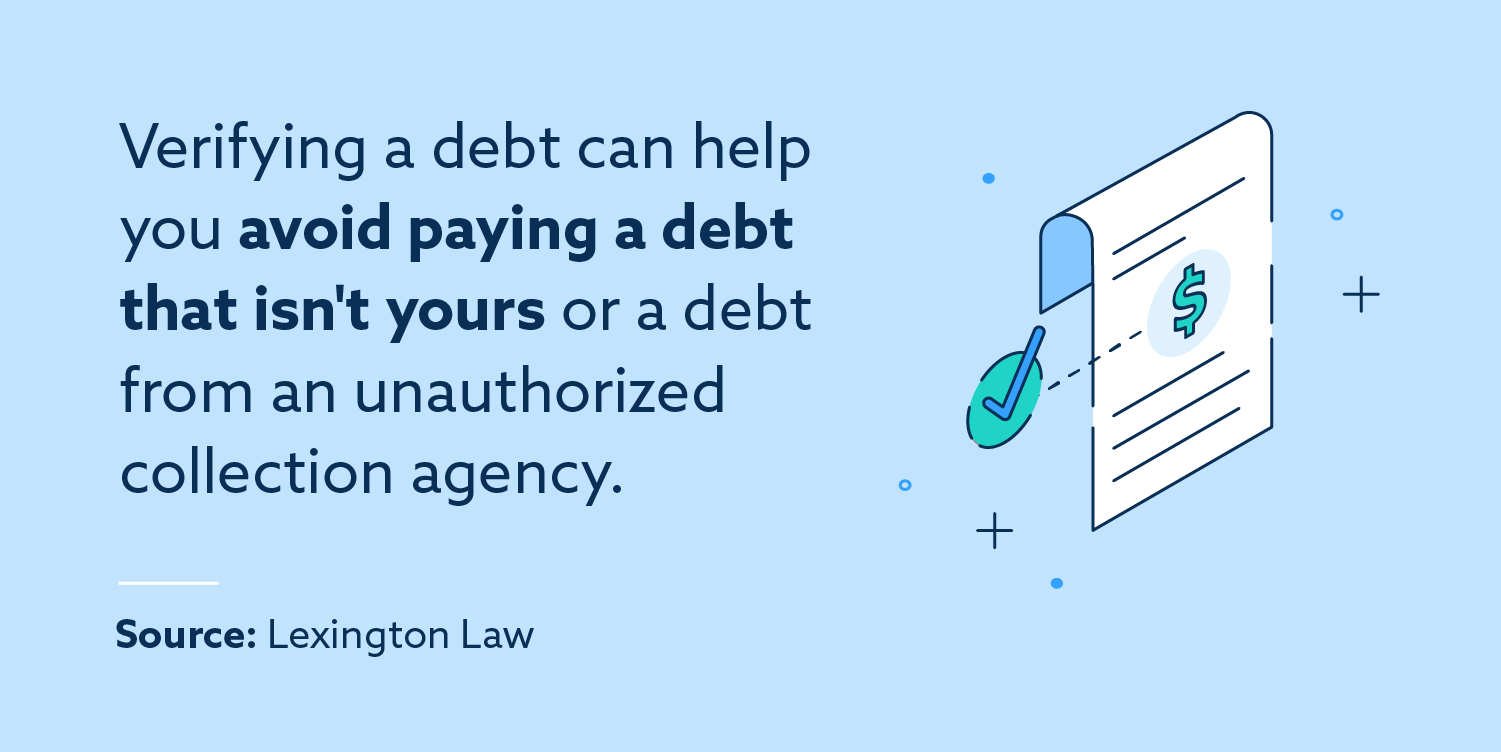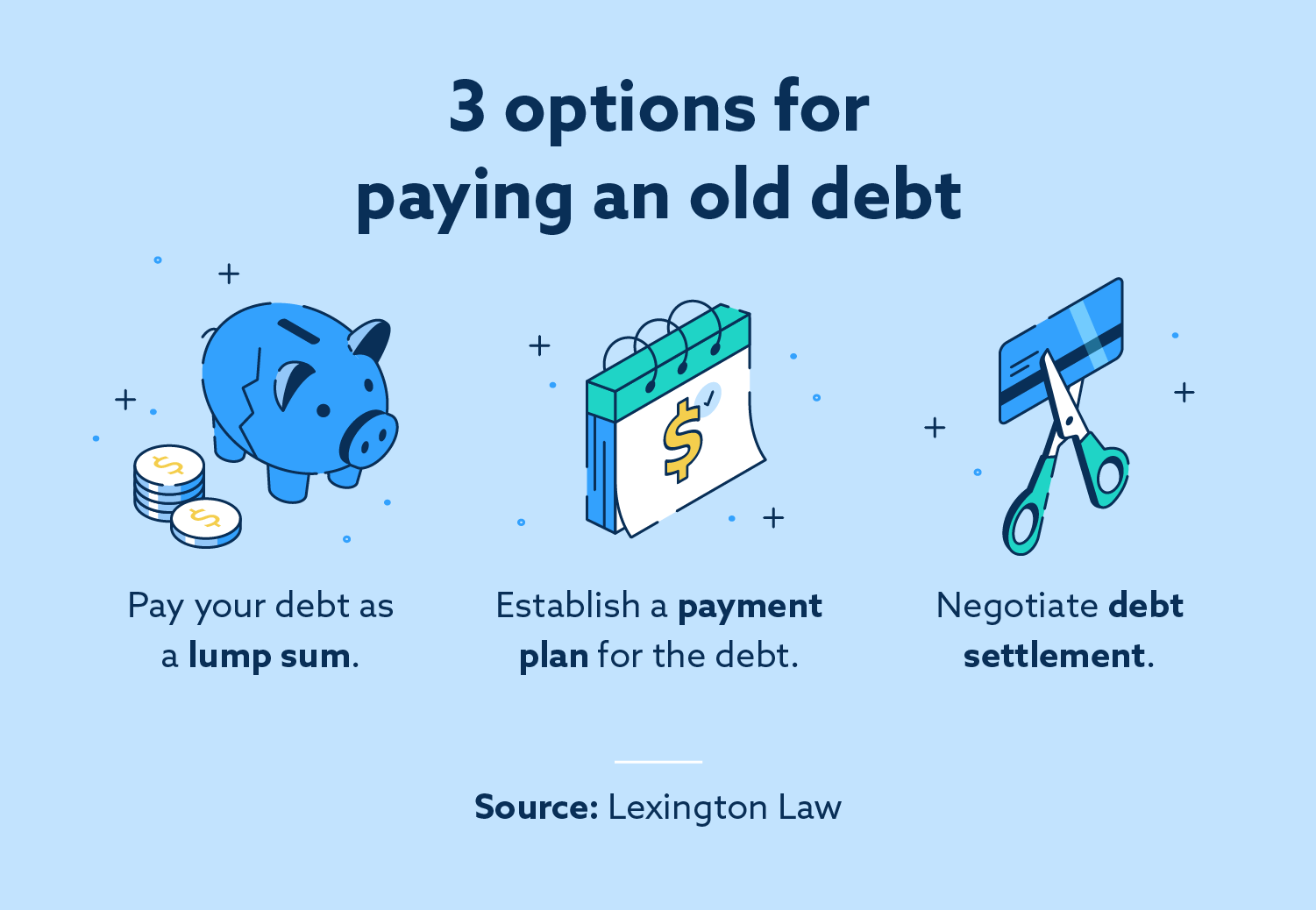
You can pay off old debt by either paying it as a lump sum, establishing a payment plan or settling the debt with the collection agency.
The information provided on this website does not, and is not intended to, act as legal, financial or credit advice. See Lexington Law’s editorial disclosure for more information.
If you have accounts in collections, you may have to pay them off if you want to qualify for a mortgage or pass a background check for a high-paying job. Paying off old debts may even help you avoid a lawsuit or reduce the amount of interest you owe. No matter why you want to pay off old accounts, it’s important to do it correctly. Find out how to pay off debt in collections in just three steps.
How to pay off debt in collections
Step 1: Make sure the debt is yours
Step 1: Verify the debt
It’s possible for a collection agency to mix up your information with someone else’s, and it’s also possible for a collection agency to engage in illegal debt collection practices. Therefore, the first step in the process is to make sure the debt is really yours.

To verify the debt, contact the original creditor and send a verification letter to the collection agency. Your letter should ask for the following information:
- Age of the account
- Amount of the debt
- Why the collection agency thinks you owe the debt
- Proof that the collection agency is authorized to collect the money
In some cases, sending this letter is enough to make a collection agency realize it made a mistake. If the agency confirms that you owe the debt, make sure you ask for the current balance. Once you know how much you owe, you can develop a payment strategy.
Step 2: Develop a payment strategy
Now you need to decide whether to pay the debt in a lump sum, set up a payment plan or settle the debt. The right choice depends on the amount of the debt and how much money you have available.

Making a lump-sum payment
When learning how to pay off debt in collections, making a single payment is certainly the easiest option. If you have enough money in the bank, you can make one payment and be done with the debt forever. Just make sure you get a payment agreement in writing before you send any money. Once you make the payment, retain your receipt and any other related documents to prove the debt has been satisfied.
Setting up a payment plan
If you don’t have much cash on hand, you may want to set up a payment plan. Before you negotiate with the collection agency, take a look at your budget and determine what you can afford to pay each month. Even if you think you can afford a $50 payment, ask the collection agency if it will accept $25 or $30. This gives you a bit of wiggle room.
Again, make sure you get a payment agreement in writing. Once you have a payment plan in place, stick to the payment schedule. If you miss a payment, the collection agency may go back on the agreement and start adding more fees and interest to your balance.
Settling the account
When you’re settling an account, the collection agency is agreeing to accept less than you owe. This takes a bit of negotiation, but it’s a good option if you’re short on cash. Before you send any money, get the terms of the settlement in writing. Make sure the collection agency won’t sell the unpaid amount to someone else, or you may end up right where you started.
If you settle a debt, be aware that you may have to pay tax on the forgiven amount. For example, if a collection agency agrees to accept $300 on a $700 balance, you may have to pay income tax on the $400 difference. If you’re concerned about the tax implications of settling your debt, meet with a certified public accountant or an enrolled agent before you start negotiating with a collection agency.
Step 3: Rebuild your credit after paying off old debt
Collection accounts can stay on your credit report for up to seven years, so it’s more important than ever for you to do your best to build and maintain good financial habits. Making on-time payments, borrowing only what you can afford to pay back and reducing your credit utilization ratio may all help you get your finances back on track. Even if paying off old accounts doesn’t improve your credit right away, you can still benefit from making positive financial changes.
Frequently asked questions
Should I pay off closed accounts on my credit report?
It depends on your financial goals and your approach to debt management. When you repay an old debt, the collection agency reduces your balance to $0. This may help you avoid additional interest charges and late fees. In some cases, paying off an old account may even help you avoid a lawsuit.
Under the FICO® 9 scoring model, paid collection accounts aren’t included in your credit score. If you pay off an account in collections, you may see your FICO 9 scores increase once the collection agency updates your credit report.
Just don’t assume that paying off an account in collections will help your credit. It may have no effect on your credit, or it may even cause your credit to take a small hit. Additionally, many lenders haven’t updated to FICO 9 yet. Even if your FICO 9 scores go up, your lender may not see them.
Charge-off vs. collection: What’s the difference?
Charge-offs and collection accounts are a bit different. A charge-off occurs when a creditor gives up on collecting payment and decides to close your account. For example, if you borrow $5,000 and don’t make any payments for 6 months, the lender may close your account instead of trying to get you to catch up.
A collection is an account that’s been placed with an internal collection department or sold to a third-party collection agency. As part of the collections process, company representatives may contact you via telephone or postal mail to try to set up a payment arrangement. For example, if the original creditor sends your $5,000 charge-off to collections, the collection agency may want you to make monthly payments until you’ve paid back the full amount.
If a creditor sells your charged-off account to a collection agency, it’s a bit of a double whammy. Instead of having one negative on your credit report, you’ll have two—the original charge-off and the new collection account.
How does paying off old accounts affect your credit score?
It depends on several factors, such as what type of account it is and how long it’s been open. If your account is 5 or 10 years old, paying it off and closing it may cause your score to drop a few points. This is because each FICO scoring model considers your average age of accounts in its scoring calculations.
Here’s an example: assume you have three accounts. The first is 10 years old, the second is four years old and the third is three years old. With all three accounts open, your average age of accounts is 5.67 years. If you close the 10-year-old account, that leaves two accounts with an average age of 3.5 years.
Your score may also change if paying off and closing the account changes your credit utilization ratio. This ratio compares the amount of revolving credit you have used to your total available credit. For example, if you have a $2,000 balance in revolving credit and a total credit limit of $10,000, your credit utilization ratio is 20 percent.
If you pay off an old medical bill, your credit may improve. This is because the three credit reporting bureaus no longer list paid medical debts on consumer credit reports. Note that the new rule only applies to outstanding medical debts. If you used a credit card to pay a medical bill and then got behind on your payments, the credit card account will still show up on your reports.
Work on your credit with Lexington Law Firm
Rebuilding your credit after having an account go to collections can be difficult, but with time and dedication, it’s possible. By building positive new credit habits, like making on-time payments and maintaining lower credit utilization, your credit is likely to improve over time. As older negative items fall off your credit report, your new positive credit history will have a larger impact on your credit health.
Throughout this process, you may want to work with a credit repair service that could help you address inaccurate information and provide credit monitoring services. Learn more by getting your free credit assessment from Lexington Law Firm today.
Note: Articles have only been reviewed by the indicated attorney, not written by them. The information provided on this website does not, and is not intended to, act as legal, financial or credit advice; instead, it is for general informational purposes only. Use of, and access to, this website or any of the links or resources contained within the site do not create an attorney-client or fiduciary relationship between the reader, user, or browser and website owner, authors, reviewers, contributors, contributing firms, or their respective agents or employers.
